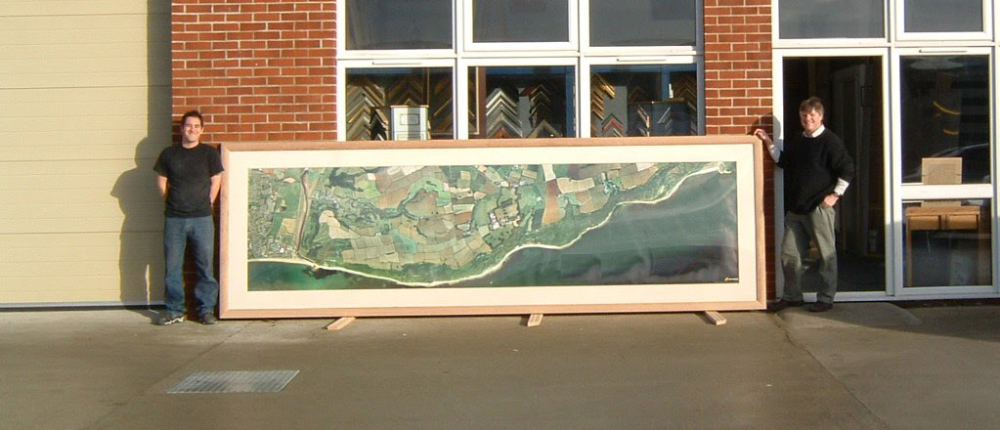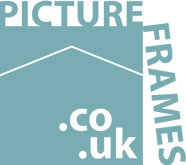glazing
Different glazing types and their uses is quite a complex subject but I hope that we can
demystify it a bit here. Let’s start with the ordinary everyday product
Standard Float Glass: The default choice, as used in picture frames for many years by all professional framers. It’s hard to scratch and inexpensive, but can break. Available in 2mm or 3mm thickness.
The float bit refers to the production process which is more flat and even than rolled glass which is used in horticulture etc.
There is quite a high iron content in this glass which gives it a greenish tinge which can detract from some artwork for example very high quality black and white photography. The reflectance of the standard float glass is approx. 8%. We are conditioned to expect these reflections but in some lighting situations they can render the artwork unviewable.

Loo Window Glass: Yes you read right and yes we are trying to put you off it!
Many picture framers sell what’s technically known as etched glass, often calling it non reflective glass . This operates by scattering the light that hits the surface, preventing obvious reflections. In fact it is stopping light from passing through the glass and so effectively stopping you from seeing through it – rather defeats the object doesn’t it?
This is what we sell to combat reflection problems:
Anti-Reflective Glass: To start with, the base glass stock has a lower iron content and so is clearer than standard glass – this is called water white glass . The improved glass base is then treated with a coating which aids the passage of light meaning that less light is reflected. The coating process was originally developed for NASA. The finished product offers crystal clear colour transmission and a virtually invisible, anti-reflective surface for truly amazing clarity. The reflectance of our anti-reflective glass is around 1%. Please be aware that 1% is still something and you will still sometimes see reflections from certain directions in certain lighting conditions
We have tested two brands of anti-reflective glass side by side as well as examining their specifications: we believe both to be of an equally high standard. Predominantly, we use Tru Vue UltraVue® UV70 but occasionally use Artglass AR 70 – the 70 by the way refers to the 70% of harmful UV light that these products filter out: not as good as the ones below but better than nothing!!

So far, we’ve only covered clarity and optical quality, now there’s another whole subject: the blocking of harmful UV light. Watercolours, old photographs, many prints and other types of artwork will fade in UV light.
Conservation Glass: Watercolours, old photographs, many prints and other types of artwork will fade in UV light. Our Conservation glass will block 99% of this UV light (from any direction) giving the highest possible protection to the artwork behind it. The reflectance of this glass is the same as Standard Float Glass.
Museum Glass: Combines all of the qualities of the anti-reflective glass with all of the qualities of the conservation glass, so: 99% UV light blocked and less than 1% reflection. However, the extremely high UV protection does add a very slight orange colour caste and fractionally reduces overall light transmission; and of course, the museum glass is expensive.
UV92: Offers the optical quality of the anti-reflective glass together with a high level of UV protection. 92% of UV light which hits the glass straight on is blocked but its efficiency is degraded for UV light coming in at an angle. It is less expensive than museum glass and is probably has the best balance of of optical and conservation performance.
Please note that even with these UV Filtering Glazing materials, you should still never hang pictures in direct sunlight .

PLEXI-GLAZE
Plexi-Glaze: When pictures get just too big for glass, we need to use lighter weight, less breakable plastic glazing (plexi-glaze). Also, sometimes safety considerations may make glass unacceptable..
We offer high quality cast acrylic whose optical and UV blocking characteristics are actually better than standard glass.
Standard acrylic has two disadvantages: the first being that it is much easier to scratch than glass. Read on about our hard coat acrylic which overcomes this problem.
The second problem is that plexi-glaze generates static electricity. For this reason, plexi-glaze should not be used for pastels, charcoals or any other artwork with migrant pigment.
2mm Clear Acrylic Glazing: Suitable for large pictures where the glazing is up to 0.86 sq.M
3mm Hard Coated Clear Acrylic Glazing: A scratch proof coating on the outside face overcomes one of the disadvantages of plexi-glaze: suitable for extra large pictures where the glazing is up to 2.03 sq.M
5mm Hard Coated Clear Acrylic Glazing: Scratch proof coating on the outside face: suitable for oversize pictures where the glazing is over 2.03 sq.M

If you’d like to read the most in depth article around on the subject of glazing works of art – try this pdf from the Tate Gallery: https://www.tate.org.uk/research/tate-papers/03/glazing-over-review-of-glazing-options-for-works-of-art-on-paper
